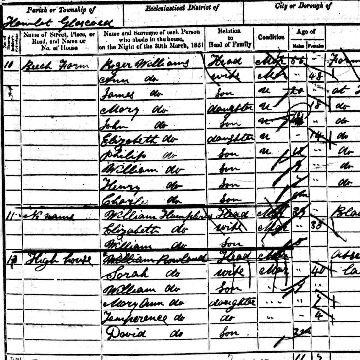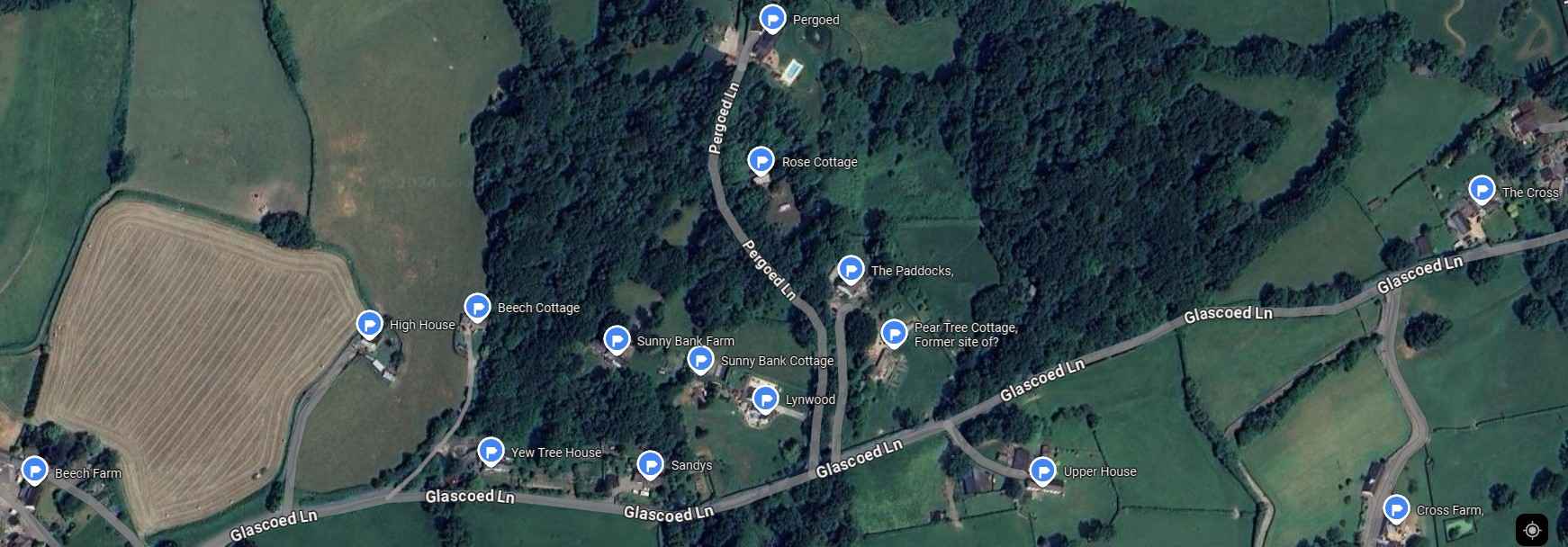
Location on old maps
Bush Cottage and “The Paddocks.”
This 1902 map from the wonderful National Library of Scotland maps website, shows the location of Bush Cottage. It is the most northerly (highest) of the three un-named houses that I have circled, situated in between Rose Cottage, Sunny Bank and Upper House, off Pergoed Lane.
We now know that the property was rebuilt in the late 19th century – certainly by 1901 and renamed “The Paddocks” in 1902.
Facts and Figures

Year of Construction
Pre-1861.

First Recorded Residents and year
1861: Philip and Hannah Lewis.

Residents at time of the 1851 census
Philip and Hannah Lewis were living at “Upper House,” which I believe was Bush Cottage – see my earlier ramblings!
Location

- Bush Cottage was situated on Pergoed Lane, and was rebuilt into the much grander “The Paddocks” at the turn of the 19th and 20th centuries.
- The Paddocks was a 12-room house and described as a “Villa” on the 1911 census. It is certainly a grander looking house than others on Pergoed Lane that were in existence at that time. It was first mentioned by that name in 1902 in a newspaper advertisement for a public auction on 5th May 1902. The advert states that the yearly tenant was “William Howells,” – who was the tenant of Bush Cottage on the 1901 census. This proves almost beyond doubt that Bush Cottage and “The Paddocks” are one and the same.
- Bush Cottage on the 1901 census was described as a 5+ rooms house.
- On the 1851 census, Philip was described as being a “farmer of six acres.” The 1902 adver tfor the auction of “The Paddocks” gave the size of the land as 6 acres and 7 perches. A 2014 house sale document for “The Paddocks” describes the property as having “6 acres” of land.
The first time that I saw Bush Cottage named as such on official records was on the 1861 census, and it continued to appear until the 1901 census.
The Paddocks is shown on the maps image further down the page.
The main characters I know of who lived at this property were Philip and Hannah Lewis. They were the first shown to be living at “Bush Cottage” on the 1861 census, although I believe it likely that the property they were living at in 1851 was also actually the building later named “Bush Cottage”.
The property where they lived at the time of the 1851 census was named “Upper House” on that census. Since there is a present day “Upper House” only a hundred or so yards away I had always assumed that the Lewises had been living there and merely moved across the road by 1861, to Bush Cottage. Now I’m not so sure. Sunny Bank Cottage was named on this census as “Lower House”, then the enumerator visited the Jones’ house “Middle House” and then the Lewises at “Upper House”. Thinking of the enumerator’s route, I believe that the natural next visiting place for the enumerator after visiting the Jones’ at “Middle House” would have been “Bush Cottage”. A house called “Twmp” was on the enumerator’s schedule at the place where I would have expected the present day “Upper House” to reasonably appear. Twmp (the welsh word for a tump) is defined as “a protrusion of land higher than that surrounding it, regardless of size.”. This certainly describes the site of “Upper House”.
UPDATE: 31st August 2024. I visited Glascoed today and got talking to one of the neighbours. We were discussing “The Paddocks” and the neighbour explained that they were shown paperwork by more recent residents of the Paddocks that ties its history back to the mid-19th century. The paperwork they remembered was some quite detailed house painting bills. I’d love to see the evidence – it would either confirm my theory or blow it out of the water! I don’t mind; I just want the history to be right.
Anyway – enough of my hypothesising; lets find out more about Bush Cottage and its residents.
Residents
Phillip and Hannah Lewis (1840s to 1890).
The first residents who I know of living at Bush Cottage were Philip and Hannah Lewis. They are an interesting couple who along with their relatives and neighbours made Pergoed Lane quite a spicy place to live in the 19th century, by all accounts.
I have written biographies on Philip and Hannah, from the pieces of information that I have found on them, so this is a broad summary.
Philip was the son of Philip and Mary Lewis and was from Monkswood. His sister Caroline married James Meredith and lived across the road, at what became later known as “Sunny Bank Cottage.” Philip was the main resident at Sunny Bank Cottage in 1841, and passed the tenancy on to his sister and brother-in-law in the early 1840s. I believe that this is when Philip and Hannah actually first came to live at Bush Cottage.
It appears from the tales I read that both his sister and his wife were characters who kept Philip’s life interesting! You can read all the juicy details on their bios!
Philip was an agricultural labourer. He married Hannah Williams on 5th October 1842 at Usk Parish Church. Hannah was from Trelech Grange and was the daughter of William and Ann Williams.
Certainly for a period of a few years in the 1860s, Philip and Hannah had an unhappy marriage. An 1864 newspaper article detailed that “the parties seem to have lived on very unhappy terms for some time,” following an incident which resulted in the judge binding Philip over to keep the peace. There were subsequent news reports from 1866 to 1869 showing fights between Hannah and her neighbour (my Great-grandmother, Sarah Pitt) which appeared to have their roots in a suspicion of Hannah’s that Sarah had been “carrying on with” Philip. Mount Zion Baptist Chapel’s minute books show that this discord with Sarah continued into the 1870s, with Hannah being “excluded from fellowship” until she could reconcile with her neighbour Sarah (now Williams).
Hannah and Philip were involved as witnesses to the Glascoed riots and possibly more. Philip’s sister Caroline (now Meredith) and her husband James were among the main targets of the rioters, for enclosing common land.
At times the Merediths and Lewises appeared to be allies although an 1869 newspaper report shows Philip as taking his nephew James Meredith to court for stealing his axe. This was perhaps a hot-headed reaction, since by the time the case came to court, Philip regretted that his nephew had been taken into custody.
I do love reading about characters like the Lewises, although I’m not so sure how much I would have enjoyed living next door to them! Of course my Great Grandfather Henry James Pitt and his parents must have had many tales to tell of the Lewises. I imagine that at first they got on well, since Philip was the Informant on John Pitt’s Death certificate and was “present at the death.” This appeared to sour after Hannah (rightly or wrongly) appeared to suspect Philip of “carrying” on with my ancestor, Sarah.
The couple lived at Bush Cottage together for the rest of their days, with Hannah dying in November 1885 and Philip in November 1890. Their graves can be found at Monkswood Parish Church.
William and Sarah Lewis (1890s).
At the time of the 1891 census, Sarah Lewis was living at Bush Cottage. The surname was probably a coincidence! She was married to William Lewis. Both had been born in Herefordshire in the 1830s, Sarah in approx 1834 at Allensmore, and William in approx 1832 at Dulas, near Ewyas Harold.
On census night, William was working away, with Mary and Charles Powers at Llanthewy Rhydderch. He was described as a Farmer (Employer). The reality would have been more likely to be that he was a farm labourer and smallholder, due to the size of Bush Cottage. I’m not too sure where they were living in 1881, although it is clear that they were at Gwehelog (the other side of Usk) in 1871, where William was a farm labourer.
They had moved to Llanthewy Rhydderch by 1901 more permanently, so it’s quite possible that their stay in Glascoed was fleeting. Sarah had died by 1911, where we see William still at the same house they were in in 1901, Little Ffawydun in Llanthewy.
William and Elizabeth Howells
The 1901 census sees the Howells family at Bush Cottage. William, the Head of the household was a 38 year old Woodcutter from Monkswood, Usk or Gwehelog depending on which census we read! His wife, Elizabeth, was a Glascoed girl. She was brought up at Lower Twyn, Glascoed, the daughter of James Williams (of the Beech Farm Williamses) and Ann Symon (an incomer to Glascoed from Devon!).
At the previous census, they had been living at Beech Cottage, just a few doors away from Bush Cottage. They had 7 children at the time of the census (Albert aged 14, Elizabeth 11, Ellen 9, William J. 8, Thomas J., George 3, and Benjamin aged 1).
I should imagine that the size of the family would have inspired the move to the larger Bush Cottage. Beech Cottage had 4 living rooms (now called Castle Corrin) while Bush Cottage had 5 or more living rooms. They had moved to “The Cross” by the time of the 1911 census.
I believe that the Howells family were the last residents of “Bush Cottage.” By 1911, no more traces are found of the name “Bush Cottage” in Glascoed and the very impressive Villa style housing of “The Paddocks” had taken its place.
Records
Censuses
“Upper House”
• 1851 – Philip and Hannah Lewis.
“Bush Cottage”
• 1861 – Philip and Hannah Lewis.
• 1871 – Philip and Hannah Lewis.
• 1881 – Philip and Hannah Lewis.
• 1891 – Sarah Lewis.
• 1901 – William and Elizabeth Howells and family.

